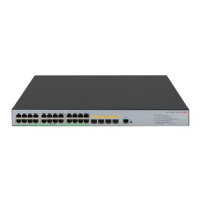346
For more information about the multicast ipv6 routing-enable command, see IP Multicast Command
Reference.
Configuring the MLD version
Because MLD message types and formats vary with MLD versions, the same MLD version should be
configured for all routers on the same subnet before MLD can work properly.
Configuring an MLD version globally
Ste
Command Remarks
1. Enter system view.
system-view
N/A
2. Enter MLD view.
mld N/A
3. Configure an MLD version
globally.
version version-number MLDv1 by default
Configuring an MLD version on an interface
Ste
Command Remarks
1. Enter system view.
system-view
N/A
2. Enter interface view.
interface interface-type
interface-number
N/A
3. Configure an MLD version on
the interface.
mld version version-number MLDv1 by default
Configuring static joining
After an interface is configured as a static member of an IPv6 multicast group or an IPv6 multicast source
and group, it will act as a virtual member of the IPv6 multicast group to receive IPv6 multicast data
addressed to that IPv6 multicast group for the purpose of testing IPv6 multicast data forwarding.
Configuration guidelines
• Before you can configure an interface of an IPv6 PIM-SM device as a static member of an IPv6
multicast group or an IPv6 multicast source and group, if the interface is IPv6 PIM-SM enabled, it
must be an IPv6 PIM-SM DR. If this interface is MLD enabled but not IPv6 PIM-SM enabled, it must
be an MLD querier. For more information about IPv6 PIM-SM and a DR, see "Configuring IPv6 PIM
(
available only on the S5500-EI)."
• A static member port does not respond to queries from the MLD querier. When you configure an
interface as a static member port or remove this configuration on the interface, the interface does
not unsolicitedly send any MLD report or an MLD done message. In other words, the interface is not
a real member of the IPv6 multicast group or the IPv6 multicast and source group.

